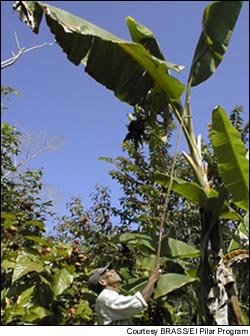
Central American Forest Gardens
 With an armload of new permaculture books
waiting on my attention, I figured it was high time to finish up my
series on traditional Central American farming practices. The
first half of Gene Wilken's Good
Farmers has already tempted me to to embark on a huge
leaf-raking project. Where will the second half lead?
With an armload of new permaculture books
waiting on my attention, I figured it was high time to finish up my
series on traditional Central American farming practices. The
first half of Gene Wilken's Good
Farmers has already tempted me to to embark on a huge
leaf-raking project. Where will the second half lead?
To start with, the book noted that Central American farmers have been
forest gardening since long before the term was invented. Large
scale farms were usually all annual vegetables, but most farmers had a
kitchen garden that modern permaculturalists would approve of.
Coconuts arched over papayas and mangos which in turn shaded cacoa,
bananas, peaches, avocados, pomegranates, ad oranges. Enough
light filtered down to the ground to feed maize and beans, and chickens
ran free under everything.
Farmers noted that their kitchen gardens required more work than their
less diverse fields of vegetables, and that crop quality was often
lower in the crowded forest gardens. On the other hand, the
farmers seldom saw weeds or pests, didn't have to worry about erosion,
and enjoyed having a diversity of food at their finger tips.
Clearly, forest gardening was worth their while.
| This post is part of our Central American Permaculture lunchtime
series.
Read all of the entries: |
Want more in-depth information? Browse through our books.
Or explore more posts by date or by subject.
About us: Anna Hess and Mark Hamilton spent over a decade living self-sufficiently in the mountains of Virginia before moving north to start over from scratch in the foothills of Ohio. They've experimented with permaculture, no-till gardening, trailersteading, home-based microbusinesses and much more, writing about their adventures in both blogs and books.
Want to be notified when new comments are posted on this page? Click on the RSS button after you add a comment to subscribe to the comment feed, or simply check the box beside "email replies to me" while writing your comment.
